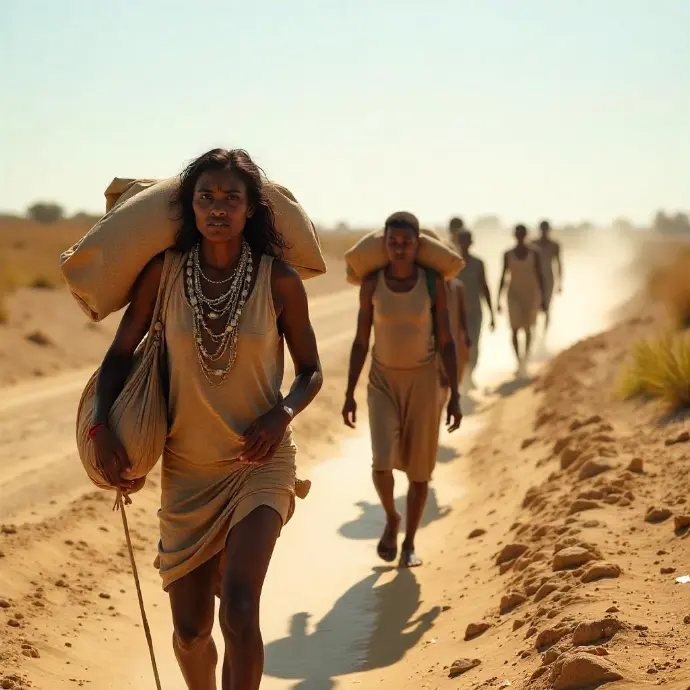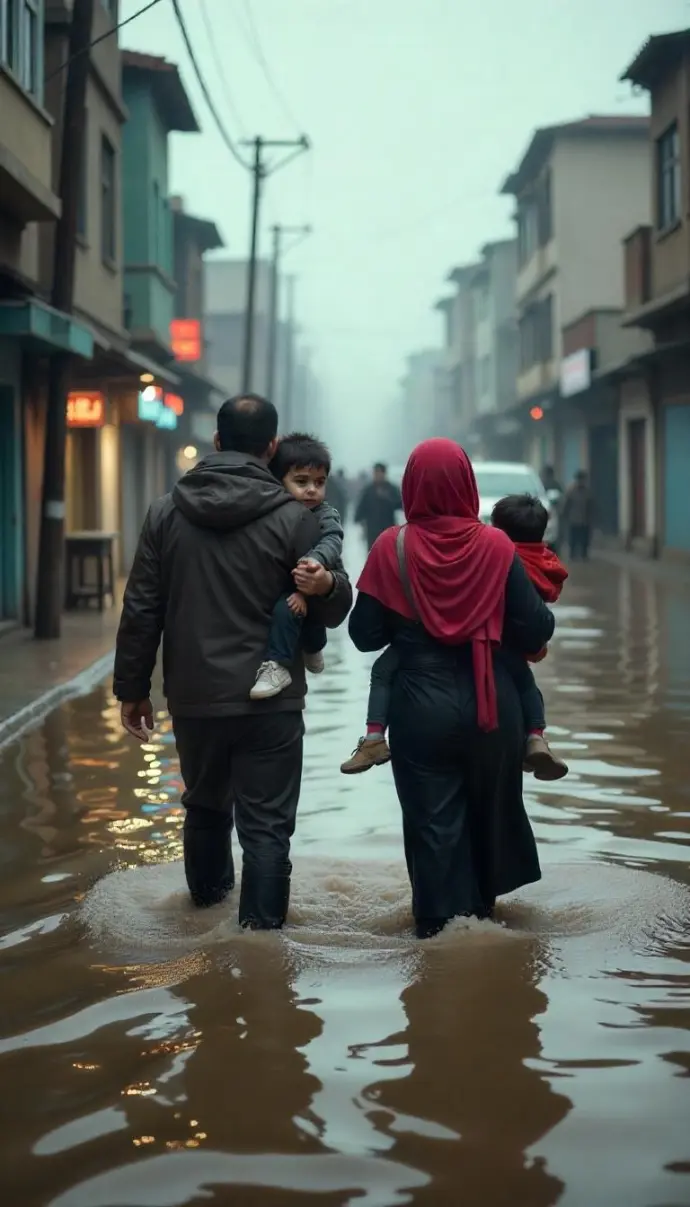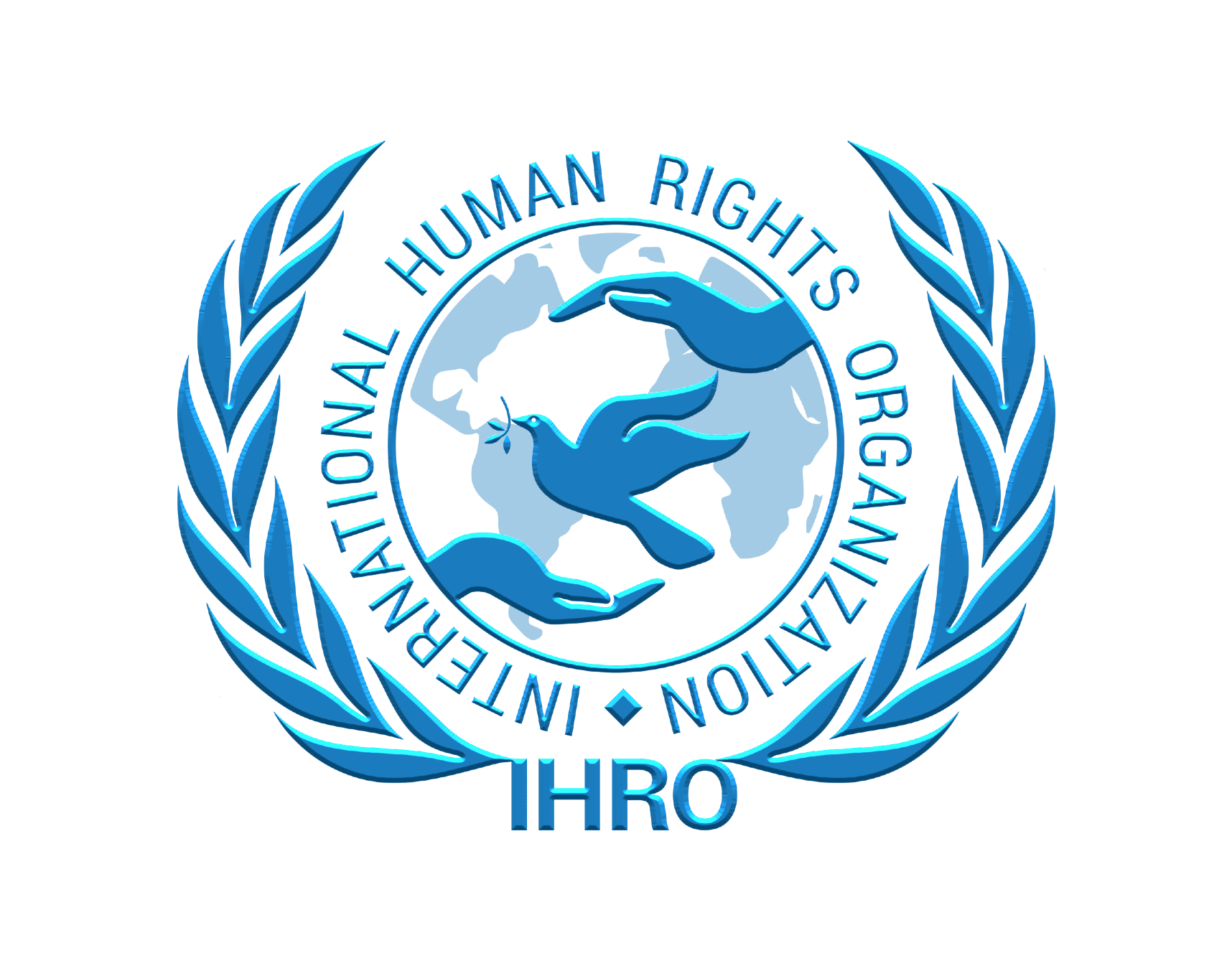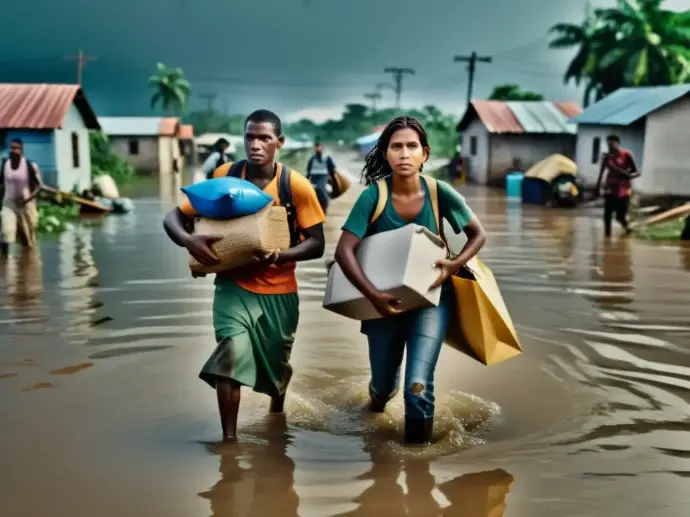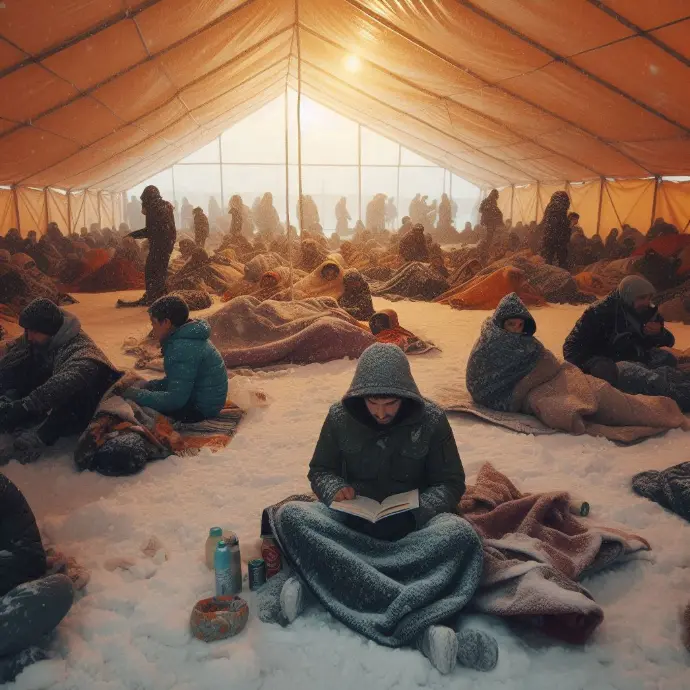Introduction
Environmental refugees are people forced to leave their homes due to natural disasters, environmental degradation, and other effects of climate change. According to the United Nations Convention Relating to the Status of Refugees, environmental refugees are not recognized as a specific category, which hinders their legal protection and access to fundamental rights.
The current situation of environmental refugees is alarming, as millions of people are estimated to be displaced due to extreme weather events, such as floods, droughts, storms, and other climate change-related phenomena. These people face the loss of their homes and livelihoods, and, in many cases, the lack of legal recognition of their refugee status.
Environmental refugees represent a global challenge that requires a comprehensive and coordinated response from the international community to ensure their protection and respect for their human rights.
Addressing the human rights of environmental refugees is crucial, as these people are in a situation of extreme vulnerability and need protection and assistance to rebuild their lives. Ensuring respect for the human rights of environmental refugees involves providing them with access to shelter, food, clean water, medical care, and employment opportunities.
Furthermore, recognizing environmental refugees as a specific category within the international legal framework is essential to ensure their protection and provide them with the opportunity to rebuild their lives in a safe and sustainable environment. The challenge lies in establishing legal mechanisms and policies that effectively address the protection of the human rights of environmental refugees, considering their unique status and the underlying causes of their displacement.
Addressing the human rights of environmental refugees is not only a matter of justice, but also of solidarity and shared responsibility in a context of the growing global climate crisis.
Climate change has a disproportionate impact on vulnerable communities, which are often the most affected by extreme weather events and environmental degradation. These communities, which include environmental refugees, often lack the resources to cope with the impacts of climate change and are forced to leave their homes in search of safer living conditions.
The increased frequency and intensity of events such as floods, droughts, and storms directly affects food security, access to clean water, and housing stability in these communities. Furthermore, climate change can exacerbate existing conflicts and generate tensions as communities compete for increasingly scarce resources.
Understanding and addressing the impact of climate change on vulnerable communities, including environmental refugees, is critical in order to develop adaptation and mitigation strategies that protect their human rights and provide them with the opportunity to rebuild their lives sustainably.
Environmental Refugees: Challenges and Vulnerabilities
Environmental refugees, also known as climate-displaced persons, face a unique set of challenges and vulnerabilities as a result of being forced to leave their homes due to natural disasters, environmental degradation, and other impacts of climate change. These people are forced to flee their homes due to phenomena such as floods, droughts, desertification, and sea level rise, highlighting the intersection between human rights and the environment.
The lack of internationally recognized legal status for environmental refugees hinders their protection and access to resources. They often face barriers to accessing the humanitarian aid and legal protection they need, further exacerbating their situation.
The absence of a specific international legal framework addressing the protection of environmental refugees leaves these people highly vulnerable, with limited legal protection and limited capacity to claim their rights in the context of their forced displacement. This highlights the need to develop and strengthen legal and administrative mechanisms to protect this displaced population and guarantee their access to justice and humanitarian assistance.
Environmental refugees often find themselves in precarious situations, with limited access to safe housing and basic services such as clean water, healthcare, and education. This forced displacement can exacerbate the poverty and marginalization of these communities, which in turn hampers their ability to rebuild their lives in a new environment.
The lack of adequate infrastructure in host locations and pressure on available natural resources can lead to tensions with local communities and generate conflicts over access to land and resources, exacerbating the vulnerability of environmental refugees.
Exposure to extreme weather conditions and the loss of traditional livelihoods also contribute to the precariousness of the situation of environmental refugees, requiring specific responses tailored to their needs.
Access to basic resources such as clean water, food, and safe shelter is critical to the survival and well-being of environmental refugees. However, the scarcity of these resources in host locations, combined with additional pressure on the environment, can make it difficult for these displaced communities to access what they need to live with dignity.
Furthermore, access to quality services, such as healthcare and education, is essential to ensuring the well-being and development of environmental refugees, but is often limited due to the lack of infrastructure and resources available to meet the needs of this displaced population.
Coordination between governments, international organizations, and civil society is crucial to ensure that environmental refugees receive the humanitarian assistance and protection they need, as well as to promote their integration into host communities.
The lack of a specific international legal framework for environmental refugees hampers their recognition and protection as displaced persons requiring assistance and support. This situation highlights the need to develop legal and administrative mechanisms that address the specific needs of this population and guarantee their access to the protection and resources necessary to rebuild their lives in safe and sustainable environments.
The complexity of the interaction between climate change, forced displacement, and existing legal frameworks requires a comprehensive approach that recognizes the multidimensional nature of the challenges faced by environmental refugees and seeks innovative solutions to address their protection and assistance needs.
Collaboration between States, international organizations, and civil society is critical to addressing the legal and administrative challenges faced by environmental refugees and to ensure that their human rights are respected and their needs are met effectively and sustainably.
Environmental refugees, when they leave their homes due to natural disasters or climate change, face extreme vulnerability to exploitation and abuse. Lacking internationally recognized legal status, these individuals are likely to be employed in precarious and low-paid jobs, thus suffering labor exploitation. Furthermore, being in a situation of forced displacement, they are often targets of human trafficking and sexual exploitation, increasing their exposure to abuse.
The lack of specific legal protection for environmental refugees leaves them in an extremely fragile position, as many international laws and treaties do not adequately address their situation. This lack of global recognition contributes to their vulnerability, leaving them exposed to various forms of exploitation and abuse.
The fight for recognition of the rights of environmental refugees is a fundamental part of defending human rights globally. The creation of legal frameworks that specifically consider and protect this vulnerable population is crucial to combating the exploitation and abuse they face, thus ensuring they can rebuild their lives with dignity and respect.
Human Rights of Environmental Refugees
International recognition of the rights of environmental refugees is essential to ensure the protection and assistance of people forced to leave their homes due to natural disasters, environmental degradation, and other climate change-related phenomena. Although there is no specific legal statute granting environmental refugee status, various organizations and countries have advocated for the inclusion of this category within the international refugee legal framework.
The 1951 United Nations Convention Relating to the Status of Refugees and its 1967 Protocol do not explicitly contemplate environmental refugees, which has generated debate about the need to expand the refugee definition to include people displaced by natural disasters and climate change-related events. Despite this legal absence, important progress has been made in recognizing the rights of environmental refugees through resolutions and declarations by international and regional organizations, as well as through the jurisprudence of some national courts.
It is crucial that international efforts continue to establish a legal framework that recognizes and protects the rights of environmental refugees, providing them with legal status that allows them access to humanitarian assistance and the necessary protection from the impacts of climate change.
Access to shelter and legal protection is one of the main concerns in the fight for the rights of environmental refugees. These people are often internally displaced or cross borders in search of a safe place to rebuild their lives. However, the lack of a specific legal framework that recognizes them as environmental refugees hinders their access to the international protection granted to traditional refugees.
In this context, it is essential that countries and international organizations work to create mechanisms that allow environmental refugees access to shelter and legal protection, guaranteeing their safety and well-being. This entails the implementation of international policies and agreements that recognize the specific situation of these people and facilitate their entry and residence in other countries in search of protection from the impacts of climate change.
The legal protection of environmental refugees is a challenge that requires a coordinated global response, involving governments, international organizations, civil society, and the academic community in the search for effective solutions that guarantee the protection of people displaced by environmental causes.
Guaranteeing basic rights such as food, health, and education is essential to ensuring the well-being of environmental refugees. These people, having fled their homes due to climate change-related phenomena, face vulnerable conditions that require immediate humanitarian assistance. Access to adequate food, health services, and education is essential to ensuring their survival and development.
Humanitarian organizations, government agencies, and the international community play a crucial role in providing humanitarian assistance to environmental refugees, ensuring they have access to nutritious food, medical care, and educational services. Furthermore, it is necessary to develop programs and policies that address the specific needs of these people, considering their situation of forced displacement and the specificities of the environmental impacts they have faced.
Guaranteeing basic rights for environmental refugees is not only a humanitarian issue but also an ethical and legal imperative. It is essential to provide assistance and protection to these people, recognizing their vulnerable condition and ensuring that they have the opportunity to rebuild their lives in conditions of dignity and respect for their fundamental rights.
Preventing discrimination and xenophobia toward environmental refugees is a crucial aspect of defending human rights. These people are forced to leave their homes due to natural disasters, environmental degradation, and other impacts of climate change, and it is essential to ensure they receive dignified and fair treatment in their new environments.
To prevent discrimination and xenophobia, it is essential to promote awareness and education about the situation of environmental refugees. Awareness campaigns can help foster empathy and understanding toward these vulnerable communities, challenging the stereotypes and prejudices that often lead to discrimination.
Furthermore, it is essential to implement policies and legal frameworks that protect the rights of environmental refugees and sanction any form of discrimination or xenophobia toward them. This includes providing equal access to housing, employment, healthcare, and other essential services, regardless of their origin. International collaboration and adherence to human rights conventions and treaties are also essential to ensure the protection of environmental refugees and prevent discrimination and xenophobia.
Global Actions and Responses
Currently, environmental refugees represent one of the most serious consequences of climate change. Faced with this reality, various nations and international organizations have sought to establish policies and agreements to protect these vulnerable communities. One of the most important milestones in this regard was the Paris Agreement, which recognized the need to protect people displaced by climate change. However, despite progress, there is still a need for a stronger legal framework committed to the protection of environmental refugees.
In addition, there are other regional agreements and bilateral treaties that address the protection of environmental refugees, although their scope and effectiveness vary considerably. It is essential that the international community continue working to create policies that provide a strong and effective legal framework for the protection of these communities affected by climate change.
It is crucial to establish clear mechanisms for the identification, protection, and assistance of environmental refugees, as well as the allocation of adequate resources for their support and relocation.
Given the growing number of communities affected by climate change, various support projects and programs have been implemented globally. These programs' primary objective is to provide humanitarian assistance, relocation support, and sustainable development to communities forced to move due to environmental impacts.
International organizations, government agencies, and NGOs have developed initiatives ranging from the distribution of humanitarian aid and the implementation of adaptation projects to promoting community resilience and protecting the rights of environmental refugees. It is essential that these programs be designed holistically, taking into account not only immediate needs but also long-term sustainability and the protection of human rights.
It is crucial that projects and programs supporting communities affected by climate change focus on the active participation of local communities, respect for their culture, and the promotion of sustainable solutions that allow them to adapt to their new reality in a dignified and safe manner.
Non-governmental organizations and human rights defenders play a crucial role in the protection and advocacy of environmental refugees. These organizations are often the first to respond to climate crises, providing humanitarian assistance, legal protection, and support in the relocation of displaced communities.
Furthermore, these organizations play a key role in raising awareness and promoting the rights of environmental refugees at the national and international levels. Their work includes documenting cases, conducting policy advocacy, and legally defending the rights of these communities, as well as collaborating with governments and international organizations to ensure an effective and coordinated response to this humanitarian crisis.
It is crucial that the work of these organizations and human rights defenders be recognized and supported, as their work is fundamental in protecting environmental refugees and promoting effective and sustainable solutions to address this growing problem.
Awareness and education on environmental refugees are critical to raising awareness of the magnitude of the problem and promoting effective actions to address it. The general population and government leaders must understand the causes and consequences of climate change-induced displacement, as well as the specific needs of environmental refugees.
Awareness raising helps build empathy and solidarity toward environmental refugees, which in turn can influence policymaking and the allocation of resources to support these vulnerable communities. Furthermore, education on this topic can contribute to preventing future displacement by promoting sustainable practices and climate change adaptation policies that protect the most at-risk communities.
Likewise, awareness and education on environmental refugees can foster international collaboration and multilateral cooperation to address this global challenge. By understanding the interconnectedness between climate change, human displacement, and human rights, individuals and countries can work together to find comprehensive and equitable solutions for environmental refugees.
Future Challenges and Recommendations
Climate change has a significant impact on the rise of environmental refugees, causing extreme events such as floods, droughts, hurricanes, and landslides. These adverse events force people to leave their homes in search of safer living conditions. According to the International Organization for Migration (IOM), it is estimated that by 2050, between 25 million and 1 billion people could become environmental refugees due to climate change.
This situation poses significant challenges for the international community, as the lack of a clear legal framework to protect environmental refugees hinders their recognition and the provision of adequate humanitarian assistance. It is essential to take concrete measures to address this growing humanitarian crisis and ensure the protection of the rights of environmental refugees.
The rise in environmental refugees also raises the need to rethink asylum and international protection systems, as current frameworks are ill-equipped to address forced migration caused by climate change. It is crucial that governments and international organizations develop effective strategies to address this complex reality and provide support to affected communities.
Faced with the growing challenge of environmental refugees, it is critical that both governments and international organizations implement more effective policies and measures at the global and local levels. This involves developing legal frameworks that recognize environmental refugee status, as well as allocating resources to provide humanitarian assistance, housing, and sustainable livelihoods to these vulnerable populations.
Furthermore, it is necessary to foster international cooperation to address the underlying causes of displacement caused by climate change. This includes implementing mitigation and adaptation measures to reduce the impacts of climate change and protect vulnerable communities. Likewise, greater collaboration between governments, non-governmental organizations, and the private sector is required to ensure a comprehensive and coordinated response to this emerging crisis.
At the local level, municipal authorities and communities must work together to develop action plans that address the specific needs of environmental refugees arriving in their areas. This may include creating integration programs, access to basic services and employment opportunities, as well as raising awareness about the challenges faced by environmental refugees.
Governments have the primary responsibility to protect and guarantee the rights of environmental refugees through the implementation of policies and legal frameworks that recognize their status and provide access to humanitarian assistance. It is also critical that governments work in collaboration with other nations to effectively address climate change-induced displacement at the regional and global levels.
Host communities also play a crucial role in protecting environmental refugees by fostering inclusion and solidarity. Civil society, for its part, can contribute through awareness-raising, promoting human rights, and providing direct support to environmental refugees.
Ultimately, addressing the rise of environmental refugees requires a comprehensive approach involving multiple actors and levels of society. Only through collaboration and coordinated action can the protection and well-being of populations affected by climate change-induced displacement be guaranteed.
In the face of the growing crisis of environmental refugees, it is essential to establish concrete measures to guarantee their protection and respect for their human rights. First, it is crucial that governments and the international community legally recognize environmental refugee status, which would allow these individuals to access the necessary protection and assistance. This specific classification is essential so that environmental refugees are not treated simply as economic migrants, but as individuals fleeing extreme and dangerous environmental conditions.
Furthermore, it is necessary to implement international policies and agreements that comprehensively address the needs of environmental refugees, including the allocation of resources for their relocation, access to health, education, and employment services, as well as the protection of their fundamental rights. Likewise, collaboration among countries should be encouraged to establish action protocols for addressing displacement caused by climate change, in order to ensure a coordinated and effective response.
Another key recommendation is public awareness and education about the situation of environmental refugees, with the aim of fostering solidarity and understanding toward these vulnerable communities. This includes promoting awareness campaigns and disseminating accurate information about the causes and consequences of climate change-induced displacement, with the aim of combating the discrimination and stigma that environmental refugees often face in host countries.
Conclusions
Environmental refugees are an increasingly relevant population in the context of climate change, and it is crucial to address their human rights comprehensively. The importance of this issue lies in the need to protect people forced to leave their homes due to natural disasters, droughts, floods, and other climate-related phenomena. This protection not only involves providing shelter and humanitarian aid, but also ensuring respect for their fundamental rights, such as access to healthcare, education, work, and safety.
The challenges in protecting environmental refugees are numerous, as they face legal, political, and social barriers when trying to find a safe place to resettle. The lack of recognition of their legal status as refugees and the absence of specific legal frameworks for their protection represent significant obstacles. However, there are also opportunities to improve their situation, such as the creation of international agreements that provide for their protection, the strengthening of early warning systems to prevent mass displacement, and the implementation of climate change adaptation programs in vulnerable communities.

